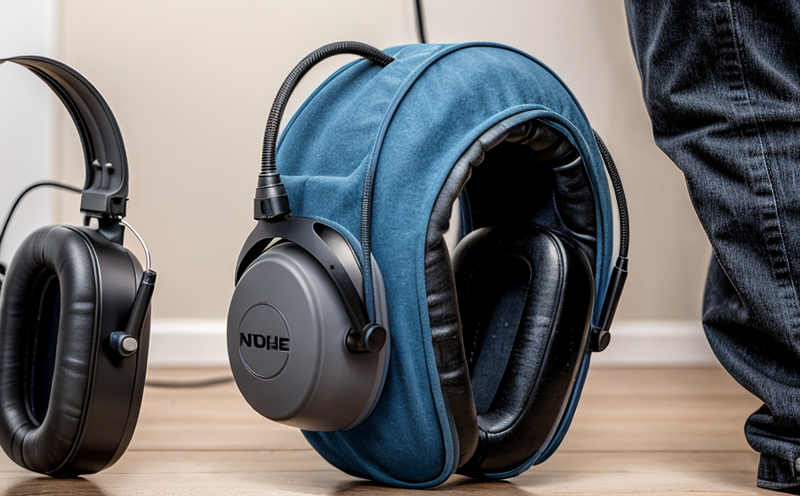EN 352-2 Earplugs Acoustic Performance Testing
The European Standard EN 352-2 defines the methods for testing earplugs to determine their acoustic performance. This standard is crucial in ensuring that hearing protection devices meet the required safety and comfort standards, thereby safeguarding workers exposed to high noise levels.
Earplugs are a common form of personal protective equipment (PPE) used to protect against excessive noise exposure, which can lead to permanent hearing damage. The acoustic performance testing ensures that earplugs provide adequate attenuation in various sound environments and meet the specified requirements for noise reduction ratings (NRR).
The test procedures outlined in EN 352-2 include several steps designed to evaluate the effectiveness of earplugs under different scenarios, including insertion loss, attenuation at various frequencies, and consistency over multiple tests. These tests are conducted using standard phantoms that simulate human ears, ensuring accurate and consistent results.
The acoustic performance testing process involves inserting the earplug into a phantom head, which simulates the shape of an adult's ear canal. Sound is then introduced through the earphone, and the attenuation levels are measured at various frequencies. The test conditions can vary depending on the specific requirements of the client or regulatory body.
Accurate testing is essential to ensure that the earplugs meet the necessary standards and provide adequate protection for workers in noisy environments. Compliance with EN 352-2 helps manufacturers, quality managers, and compliance officers demonstrate that their products comply with international safety regulations. This ensures that the products are effective, reliable, and safe for use.
The testing process is highly technical, requiring precise measurement equipment and controlled conditions to ensure accurate results. The acoustic performance of earplugs can be significantly affected by factors such as insertion method, depth, and fit, which underscores the importance of thorough testing.
- Consistency in Results: Ensuring that the same earplug yields consistent attenuation levels across multiple tests is crucial for reliability.
- Real-World Applications: The test conditions are designed to simulate real-world use, ensuring that the results accurately reflect performance under actual working conditions.
- Compliance with Standards: Meeting the requirements of EN 352-2 ensures compliance with international safety standards and regulatory requirements.
The acoustic performance testing process is a critical step in ensuring that earplugs provide adequate protection against noise exposure. Compliance with this standard helps manufacturers, quality managers, and compliance officers demonstrate that their products meet the necessary safety and performance criteria.
By adhering to EN 352-2, organizations can ensure that they are providing workers with high-quality hearing protection devices that effectively reduce noise levels in various environments. This not only enhances worker safety but also contributes to a healthier and more productive work environment.
Benefits
The benefits of conducting acoustic performance testing on earplugs according to EN 352-2 are numerous, particularly for organizations that prioritize worker safety and compliance with international standards. By ensuring that earplugs meet the necessary requirements, these tests provide several advantages:
- Enhanced Safety: Acoustic performance testing ensures that earplugs effectively reduce noise levels, protecting workers from potential hearing damage.
- Compliance with Standards: Meeting EN 352-2 helps organizations comply with international safety regulations and industry best practices.
- Precision in Results: The standardized testing process yields consistent and reliable results, ensuring that the earplugs perform as expected under various conditions.
- Improved Product Quality: Testing ensures that the acoustic performance of earplugs meets or exceeds specified requirements, leading to higher-quality products.
- Reduced Risk of Accidents: By providing effective hearing protection, these tests help reduce the risk of accidents caused by noise-induced distractions.
- Enhanced Reputation: Demonstrating compliance with international standards enhances an organization's reputation and builds trust among clients and stakeholders.
In summary, acoustic performance testing on earplugs according to EN 352-2 provides significant benefits for organizations that prioritize worker safety, compliance, and product quality. By ensuring that the acoustic performance of earplugs meets the necessary standards, these tests contribute to a safer and more productive work environment.
Eurolab Advantages
At Eurolab, we are committed to providing top-tier testing services for earplugs according to EN 352-2. Our expertise in this area ensures that our clients receive accurate and reliable results, helping them comply with international safety standards and meet the necessary requirements for noise reduction.
- State-of-the-Art Equipment: We utilize advanced testing equipment to ensure precise measurements and consistent results.
- Experienced Technicians: Our team of skilled technicians is highly trained in conducting acoustic performance tests according to EN 352-2, ensuring accurate and reliable results.
- Comprehensive Testing Services: We offer a wide range of testing services for earplugs, including insertion loss, attenuation at various frequencies, and consistency over multiple tests.
- Regulatory Compliance: Our services are designed to help organizations comply with international safety regulations and industry best practices.
- Customized Solutions: We understand that each organization has unique testing needs. Our team can customize our services to meet your specific requirements.
- Expert Guidance: Our experienced professionals provide expert guidance throughout the testing process, ensuring that you have a clear understanding of the results and recommendations.
At Eurolab, we are committed to delivering high-quality testing services for earplugs according to EN 352-2. Our expertise in this area ensures that our clients receive accurate and reliable results, helping them comply with international safety standards and meet the necessary requirements for noise reduction.





